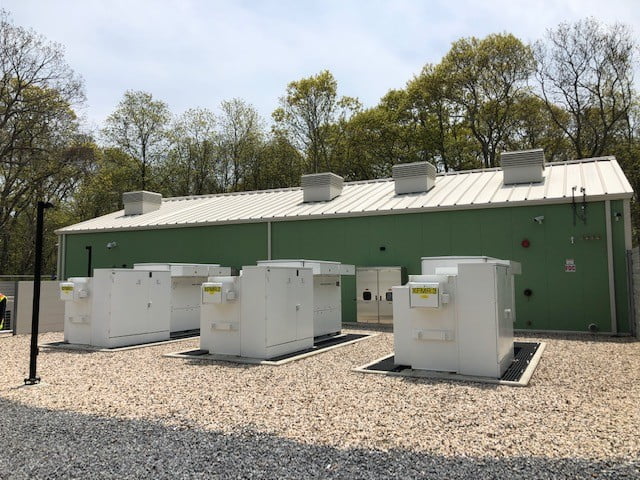
Just before the end of May, a 5MW/40MWh battery energy storage system (BESS) in East Hampton, on New York’s Long Island, experienced an “isolated fire”. The system is owned by National Grid and was developed in partnership with a NextEra Energy Resources subsidiary.
East Hampton Energy Storage Center (EHESC), located near a high voltage substation operated by the Long Island Power Authority (LIPA), is a non-wires alternative (NWA) aimed at helping utility LIPA manage its growing peak load in a highly grid-constrained area. It came online in 2018, and will also help integrate to the grid the output of South Fork Wind, a 132MW offshore wind farm currently under construction.
“There was an isolated fire at our East Hampton facility in May. We are working diligently to repair the facility, and expect to do so over the coming months. We will have a more definitive timeline and damage assessment once a thorough review is complete,” NextEra Energy Resources spokesperson Mike Mazur, told Energy-Storage.news.
Replying to an enquiry from this site and speaking on behalf of NextEra and partner National Grid, Mazur said that in the meantime, “there are no safety or power concerns for local residents as a result of the facility being out of service”.
Describing the safety of employees and the local communities served as “the foundation of our projects,” the NextEra spokesperson said the system’s water-based fire suppression system operated as designed, quickly containing the fire to the site, with no further emergency response required.
Local news outlets reported local roads being out of use as the situation unfolded, as well as rail transit, but this is thought to have only lasted a couple of hours as precautions were being taken. Developers behind the South Fork Wind project said that the site’s substation was also evacuated for a couple of hours as a precaution.
According to Mazur, the company’s energy storage facilities are “managed, monitored and cooled in a controlled manner to keep the equipment functioning safely”.
The incident goes some way to demonstrate that NextEra’s storage facilities “have extensive fire protection systems, which respond immediately to an incident,” as last month’s quick response to the fire at East Hampton showed, the spokesperson said.
Second incident occurred during recent heavy storms
More recently, fire alarms two of four battery storage systems deployed in Warwick, a town in New York’s Orange County about three and a half hours’ drive inland from East Hampton on the evening of 26 June.
As with the East Hampton incident, fire suppression units within the affected battery containers kicked into action, but a fire started at one of the two sites the following day. According to project developer Convergent Energy and Power, which owns and operates the systems, the other affected site continued to experience unspecified “problems”.
The two were part of a four-system non-wires alternative (NWA) project delivered by Convergent Energy and Power for local utility Orange and Rockland (O&R), totalling 12MW/57MWh. Aimed at reducing the need for O&R to make more expensive upgrades to its distribution network, they comprise identically-sized 4MW units. They went into commercial operation in May, as reported by Energy-Storage.news at the time.
The incident happened amid heavy storm conditions that took out some of O&R’s other electrical infrastructure.
“At this time there is a lot we still do not know,” Convergent Energy and Power said in a statement posted to its website on 29 June, following an initial reaction statement posted the day the fire began.
The company took what is perhaps an unusual step in naming the make and model of the BESS equipment involved, identifying the containerised systems as system integrator and manufacturer Powin Energy’s Centipede modular BESS solution for large and utility-scale applications.
“Convergent, which purchased these systems from Powin, does not have this model deployed anywhere else and was among the first customers to receive the system from Powin. The Powin Centipedes are the only systems that are currently experiencing problems at Convergent’s Warwick, NY projects,” the company said.
Powin’s team, as manufacturer of the systems, is now assessing the source of the problem and coordinating a response, Convergent Energy and Power said.
Powin Energy sent Energy-Storage.news its own comment on the incident, noting that “Powin, Convergent, and Orange & Rockland and local fire officials all actively coordinated management of the event”.
“We are supporting our customer and first responders in any way needed. We are happy to report that no one was harmed. The safety of our employees and the surrounding area are the top priorities for Powin.”
The state of New York has some of the most stringent fire regulations in place around the world, although this is particularly the case in urban New York City. Fire incidents at BESS installations are rare, as can be seen from the EPRI Battery Failure Event Database, which keeps a tally, albeit this information is scraped from media reports and does not appear to be updated full-time; the Convergent Energy and Power incident is not on there as yet, for example.


